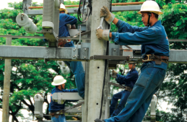In late February, the Philippine’s Department of Energy announced it was forging ahead with plans to offer 15 offshore territories to foreign investors for oil and gas exploration. The secretary of energy, Jose Almendras, said the government hoped to award contracts to the winning bidders this month, underscoring the government’s desire for work to begin as soon as possible.
Indeed, the Philippines is keen to increase its natural gas production to meet rising domestic demand for gas-fired power. This demand is projected to almost double from the current 2700 MW per day to 5000 MW by 2016.
At present, there are major concerns regarding upcoming shortfalls in capacity, particularly in Visayas and Mindanao. The country’s domestic electricity expansion plans would therefore be well-served by the discovery and production of natural gas for firing new gas-turbine generator plants.
According to BP’s “Statistical Review of World Energy 2011”, the Philippines consumed 3.1bn cu metres of natural gas in 2010, slightly down from 3.3bn cu metres in 2008 and 2009.
In terms of supply, the Philippines had an estimated 98.54bn cu metres of proven natural gas reserves as of January 1, 2011, according to the CIA World Factbook. While there may be additional untapped reserves in the new offshore territories, there are currently no official figures to gauge just how much there may be.
The country may also be sitting on huge reserves of oil. A March 2008 US Energy Information Administration report estimated proven and undiscovered oil reserves in the South China Sea could range from 28bn barrels to as much as 213bn barrels of oil. The highest number would exceed every other country’s proven oil reserves – except those of Venezuela and Saudi Arabia, according to the BP Statistical Review.
Some of the new offshore blocks are not without political and diplomatic controversy, though. The 15 offshore territories that will be open for exploration include two areas – areas three and four, about 80 km north-west of Palawan province – that China claims as part of its sovereign territory. Vietnam, Brunei Darussalam, Malaysia, Indonesia and Taiwan have also long claimed sovereignty over partly overlapping areas of the South China Sea.
Addressing this at the first EU-Philippines Energy Meeting, Almendras said, “We offered these service contracts which the Republic of the Philippines believes are within its territorial claims.” Areas three and four are located near the disputed Reed Bank area, the subject of controversy in March of 2011 when a UK-based Forum Energy survey vessel was chased off by two Chinese ships.
The Philippines’ government asserts that Reed Bank is within the country’s 200-nautical mile exclusive economic zone and is not part of the disputed areas in the South China Sea, though the area is also claimed by the People's Republic of China, Taiwan and Vietnam. “There is no uncertainty as far as the Republic of the Philippines is concerned,” Almendras said.
However, on the same day, Radio Australia News reported that the Philippines’ secretary of foreign affairs, Albert del Rosario, said his country was open to joint development with other countries that claimed to own disputed areas in the Spratly Islands, such as the Reed Bank.
Perhaps in an effort to defuse what could become a heated argument over the rights to the gas and oil reserves in the area, del Rosario said Manila might invite China to invest in the development of the Reed Bank. He added that any joint developments would apply only to disputed territory in the Spratly Islands, and not those that the Philippines claims belong to the country.
Whether this potential proposal will calm the nerves of all involved in the disputed areas will be very closely watched as service contracts are awarded.
Looking ahead towards diversification of fuel mix, at the same energy meeting between the EU and the Philippines, Almendras urged European countries to consider the Philippines as a place where they could “experiment” with ocean technology, which is seen as an alternative source of energy for island nations.
Indeed, the government has already asked the UN Industrial Development Organisation to host a global research and development centre for existing and emerging ocean technologies in the Philippines, Almendras said.
The Philippines’ first ocean-energy facility is set to launch commercial operations by 2018. The government hopes their facility will help stimulate investors’ interest in exploring and developing the untapped potential of the country’s ocean energy resources.
While its future may be a bit murky, it is clear that whatever happens next under the waters of the South China Sea – be it tapping into its natural gas and oil reserves or harnessing the ocean’s energy – will be of crucial importance, not just to the Philippines’ energy ambitions, but to those of the entire region.

